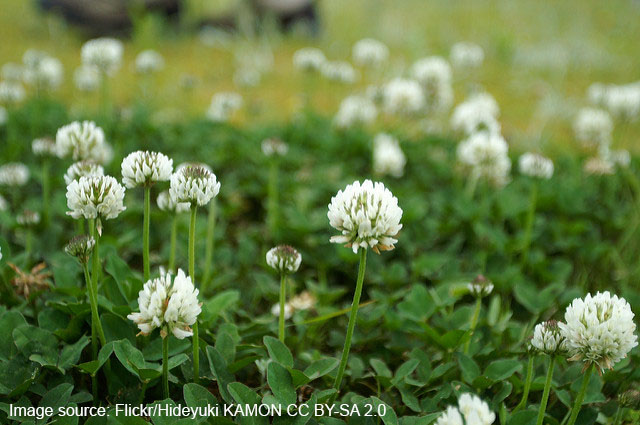Pollinator Lawns

How can you make your lawn more supportive for pollinators?
Watch this video of current lawn trends!
1. Reduce the area that you need to mow.
The first step you can do is reduce the area you need to mow. Evaluate your property and outline what parts are actually used as lawn, and what parts could be expanded into flowering beds, flowering trees, or left more natural. Many homeowners find that they can easily reduce the area that they mow, without changing how they use their yard. Not only does this improve your property for pollinators and other wildlife, but it saves time, money, and energy!
- For native plant info, including local sources for native plants, see our page on large-scale pollinator habitat.
- For more information on what trees you can add around your lawn, visit our site on pollinator supportive trees.
- More ideas can be found at University of Minnesota Bee Lab's Bee Lawns page, University of Maryland Lawn Alternatives page, and the PennState Extension Lawn Makeover Toolkit.
- For guidance on how to use sheet mulching to turn lawn into plantings read the sheet mulching guide from Oregon State University or the California Native Plant Society, and watch this video from Penn State.
2. Keep the flowering volunteers in your mowed portion.
Plants like dandelions and white clover are low-growing, so you can still mow your lawn and provide food for pollinators. Another benefit of white clovers is that they are are nitrogen fixers, meaning they add nitrogen back into the soil. Nitrogen makes your lawn happy! Read for more information on clover lawns at clowerlawns.org - including how to overseed your already planted lawn.
To overseed your existing lawn:
- Mow very short
- Rake and remove as much thatch as possible
- Seed liberally with clover seed
- Water well for the first week, and then weekly until established
3. Be careful when, what, and where you spray.
Only use products if you absolutely have to, and remember that pesticides can have harmful effects for pollinators, even if that is not written explicitly on the label. If you spray a systemic pesticide like imidacloprid for grubs, be careful of trees near your lawn. Tree roots can absorb systemic pesticides, which end up in their pollen and nectar which bees eat. If you do have a flowering lawn, consider mowing before you apply anything so that pollinators will not be attracted to it.
- You can learn more about controlling grubs in the MSU Smart Gardening document Smart lawn care to protect pollinators.
- More information is available on our page Minimizing pesticide exposure to pollinators.
- Read our Bee Aware brochure to ensure you are understanding the label correctly.
4. Establish a new flowering lawn
Planting a new lawn is a lot of work, and you want to make sure that your plants become well established quickly. The preparation, seed mix, and care will all depend on your soil type, drainage, slope, shade etc. Don't hesitate to ask experts for help in the planning phase. Oftentimes, local seed and plant producers are willing to help and already understand the conditions in your area, and will be happy to provide recommendations. You can also get your soil tested at MSU. This will tell you what nutrients you have in your soil and how much fertilizer you might need in the beginning to get the best results. For specific questions you can use Ask Extension - https://pollinators.msu.edu/questions/
- MSU Smart lawn alternatives to protect pollinators
- Planting and maintaining a bee lawn - University of Minnesota
- Flowering Bee Lawns for Pollinators - University of Minnesota
- Blue Thumb Pollinator Lawns
- EarthEasy Lawn Alternatives- How to reduce your lawn care costs while lessening your yard's environmental impact
Once you have a plan, you can begin to prep your site. For best results, you have to kill grass and weeds before you plant. This can be done using a nonselective herbicide like glyphosate, soil solarization, or prescribed burns. If you don't want to use an herbicide, you can dig out the existing lawn and solarize the soil instead. If you live in a rural area and have a huge lot to prepare for a flowering lawn, you may want to try prescribed burning to kill existing turf. Keep in mind that city lots cannot be burned with fire and prescribed burning requires a specialist to ensure safety. Learn more about each of these processes in the links below.
- UC Davis Soil Solarization
- Soil Solarization for Gardens and Landscapes
- UC Davis Killing Lawn with Herbicides
- Michigan Prescribed Fire Council
After killing your grass and weeds using one of the previous methods, work with an expert or read guides to plant and maintain your flowering lawn. So many written guides and resources can help you get started and learn all of the steps. Check out the resources for flowering pollinator lawns below to get started.
- Watch the Pollinator Stewardship Council A yard becomes a pollinator habitat
- Xerces Society: Pollinator Habitat Installation Guides
- What is a pollinator lawn fact sheet